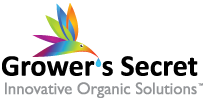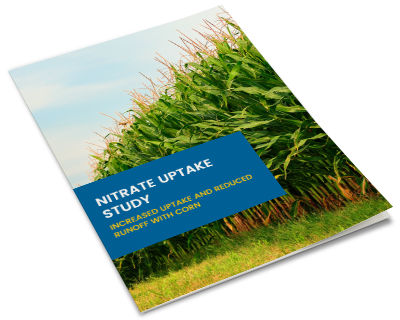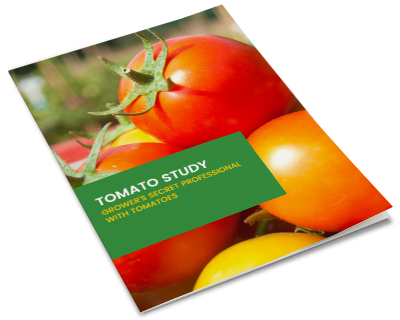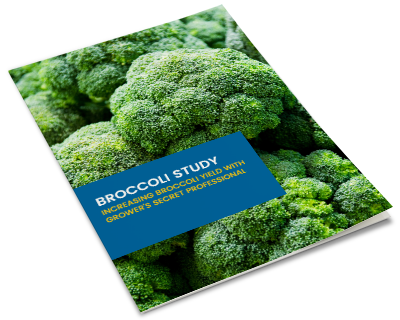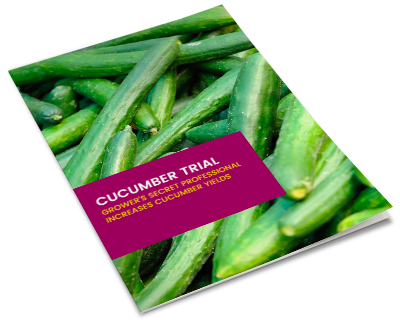|
Posted By: Wesley Chun, Ph.D. / |
Nitrogen is a Plant's Best Friend
Written By: Wes Chun, PhD // Co-Authored By: Sophie Rogers
Nitrogen is the second most important nutrient for plants, with carbon being the first. It constitutes three to four percent of a plant’s biomass. It is a key component in biological molecules such as DNA, RNA, enzymes, proteins, and important compounds such as chlorophyll. Fertilizers, organic matter, and biological nitrogen fixation are sources of nitrogen for agricultural crops. Selecting the right nitrogen source will be instrumental towards efficiently producing a crop.
There are numerous synthetic and organic options to provide nitrogen to plants. Synthetic nitrogen fertilizers can be useful if used properly. Complex organic fertilizers such as chicken litter are great for providing nitrogen throughout the growing season. Amino acid fertilizers offer a low risk, rapidly available form of nitrogen. Amino acid fertilizers can be used to ameliorate nitrogen deficiencies or to provide additional nitrogen for nitrogen hungry plants such as leafy vegetables and corn.
Nitrogen for plants comes in various forms. Atmospheric nitrogen can be converted to plant-available amino acids by symbiotic rhizobial bacteria or free-living bacteria such as Azotobacter and Cyanobacterium. Conventional agriculture uses synthetic quick release nitrogen fertilizers such as ammonium nitrate and urea. Organic agriculture has a number of options for delivering nitrogen that range from slow to quick release. For example, poultry litter is a slow-release fertilizer that requires microbial activity to release plant available amino acids. On the other hand, products containing water-soluble amino acids are immediately available for plant use and are thus considered fast release.
| Organic Fertilizer | Estimated NPK | Nutrient Release |
| Alfalfa meal | 2.5 - 0.5 - 2.0 |
Medium fast |
| Bat guano | 5.5 - 8.6 - 1.5 | Medium |
| Blood meal | 12.5 - 1.5 - 0.6 | Slow |
| Bone meal | 2-3 - 14-22 - 0 | Slow |
| Dried manure | Variable | Medium |
| Feather meal | 15.0 - 0 - 0 | Slow |
| Fish meal | 10.0 - 5.0 - 0 | Medium |
| Grower's Secret Corn Steep Powder | 7 - 6 - 4 | Fast |
| Grower's Secret Phosphorus + Ca | 0 - 9 - 0 + 30% Ca | Slow |
| Grower's Secret Seaweed | 0 - 0 - 16 | Fast |
| Grower's Secret Granules | 8 - 3 - 1 | Medium - Fast |
| Grower's Secret Nitrogen | 16 - 0 - 0 | Fast |
| Kelp meal | 1 - 0.5 - 8.0 | Slow |
| Seabird guano | 12.3 - 11.0 - 2.5 | Slow - Medium |
| Worm Castings | 1.5 - 2.5 - 1.3 | Medium |
Transportation of Amino Acids
Roots and shoots have active and passive uptake systems for small molecules such as ammonia, nitrates, and amino acids. In passive uptake systems, small synthetic molecules and amino acids move from higher concentrations outside the plant to lower concentrations inside the plant through natural plant openings. Active transport systems require plant energy and play an important role for nutrient uptake when concentration gradients from the environment into the plant are low. Root and shoot applications of plant available nitrogen can quickly ameliorate deficiency symptoms. Amino acid-based products are very low in salt and do not cause salt injury while synthetic fertilizers are mineral salt based so care must be taken to avoid injury.
A nitrogen deficiency can manifest itself as early or late symptoms. Early symptoms include slow growth and uniform yellowing of older leaves. Late symptoms include smaller fruit, leaves and shoots which may also develop later than normal. In broadleaf plants, leaves may be more reddish than normal and may drop prematurely. Grains may exhibit reduced tiller development and the stand may appear thin. Luckily, amino acids may be used to address in season nitrogen deficiencies.
|
Nitrogen Deficiency Symptoms |
|
| Early symptoms | Slow growth and uniform yellowing of older leaves |
| Late symptoms | Smaller or delayed shoots, leaves, and fruits |
Amino acids have two major attributes that make them valuable tools for nitrogen fertilization of crops. First, they are readily absorbed by plants through the foliage and roots. They have low levels of salt, they can be used as a foliar spray or ground application with no risk of burning. Additionally, amino acids are used directly by the plant to make enzymes and proteins. In contrast, plants have to expend energy to convert conventional products such as nitrates into ammonia to manufacture amino acids before enzymes and proteins can be manufactured. The plant energy saved when amino acid based products are used can thus be used for other plant metabolic processes such as growth, reproduction, and responding to biological and environmental stresses. Nitrogen uptake and metaolism is shown in Figure 1 below.
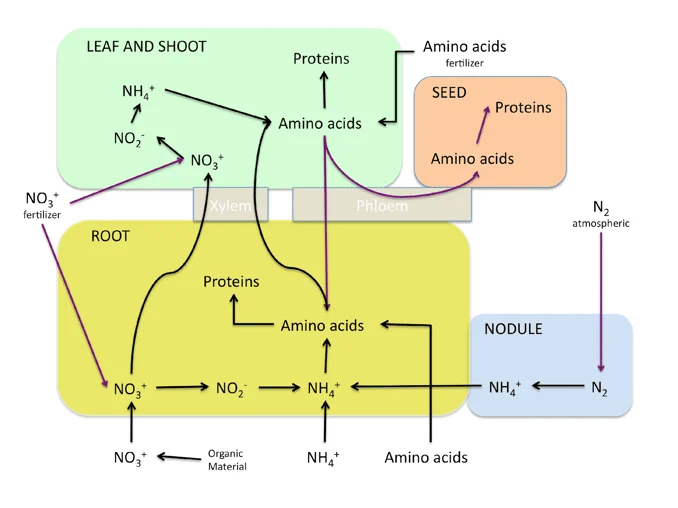
Plants have active and passive transport systems to uptake nitrates, ammonium, and amino acids. Recent evidence also indicated that small peptides are also taken in by plant roots or can be mobilized by mycorrhizal associations. As shown in Figure 1, amino acids are the major form of nitrogen currency in the plant and are transported by both the xylem and phloem. Nitrates are transported only in the xylem. Plant metabolic energy is used to oxidize it into ammonium and then synthesized into amino acids, before protein synthesis can occur. Amino acids on the other hand are directly used by the plant to manufacture proteins and enzymes. The metabolic energy saved by using amino acids can be used for other plant processes.
While nitrogen fertilizers have great value in producing a healthy crop, proper amounts should be used. Excess applications of conventional fertilizers could lead to higher ammonium and nitrate levels in the soil that could be lost via volatilization or leaching, respectively. Plant performance surveys, combined with soil, sap and plant tissue analyses are essential for determining in season applications of supplemental nitrogen. In planning your season, the amount of amino acids required in season can be estimated based on your crop nutrient requirements, soil organic matter, yield goals and the growing environment.
A soil fertility analysis will characterize the nutrient levels in your soil and tissue and sap analyses can determine nutrient levels in your plants. You can then select the right nitrogen fertilizer amount and application timing for your crop. Looking to incorporate amino acids into your nutrient regimen? Check out our Grower's Secret Nitrogen 16-0-0 or Liquid Nitrogen 8-0-0. Call Chuck or Kim with any questions regarding application or pricing. (888) 467-4769

